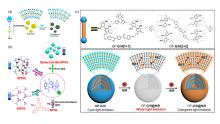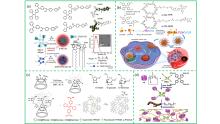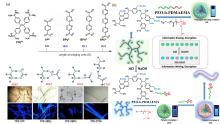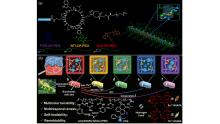有机化学 ›› 2023, Vol. 43 ›› Issue (12): 4075-4105.DOI: 10.6023/cjoc202305010 上一篇 下一篇
综述与进展
收稿日期:2023-05-10
修回日期:2023-06-30
发布日期:2023-07-27
基金资助:
Huiming Lua, Lamaocao Mab, Hengchang Maa,*( )
)
Received:2023-05-10
Revised:2023-06-30
Published:2023-07-27
Contact:
*E-mail: Supported by:文章分享

通过超分子自组装构建发光材料是超分子化学研究的重要领域之一. 超分子自组装作为一种简单且高效的手段, 可以将不同结构的分子通过非共价键作用力构建成具有精确结构和多功能的组装体, 进一步赋予了超分子材料独特的物理特性. 由于超分子发光材料中非共价键相互作用力具有动态且可逆的性质, 因此使其具有对刺激物特异性识别和对微环境变化敏感的特点, 从而被广泛应用于生物传感和成像、药物传递、化学传感、人工光收集系统、信息加密和光催化等领域. 基于此, 为了了解超分子发光材料的最新研究进展, 主要按照氢键相互作用、π-π堆积和多种非共价键相互作用, 较系统地阐述了最近四年超分子发光材料, 从设计到制备再到应用的最新研究进展, 并且进一步展望了其未来所面临的挑战.
鲁会名, 马拉毛草, 马恒昌. 超分子聚集诱导发光材料的研究进展及展望[J]. 有机化学, 2023, 43(12): 4075-4105.
Huiming Lu, Lamaocao Ma, Hengchang Ma. Research Progress and Prospect of Aggregation-Induced Emission Supramolecular Luminescence Materials[J]. Chinese Journal of Organic Chemistry, 2023, 43(12): 4075-4105.




























































| [1] |
(a) Abbas M.; Atiq A.; Xing R.; Yan X. J. Mater. Chem. B 2021, 9, 4444.
doi: 10.1039/D1TB00025J |
|
(b) Giuri D.; Ravarino P.; Tomasini C. Org. Biomol. Chem. 2021, 19, 4622.
doi: 10.1039/D1OB00378J |
|
|
(c) Ke R.; Lin Z.; Zhang H.; Zhou S. J. Phys.: Conf. Ser. 2022, DOI: 10.1088/1742-6596/2324/1/012007.
|
|
| [2] |
Pederson C. J. J. Am. Chem. Soc. 1967, 89, 7017.
doi: 10.1021/ja01002a035 |
| [3] |
(a) Zhang G.; Mastalerz M. Chem. Soc. Rev. 2014, 43, 1934.
doi: 10.1039/c3cs60358j pmid: 29090209 |
|
(b) James T. D. Front. Chem. 2017, 5, 83.
doi: 10.3389/fchem.2017.00083 pmid: 29090209 |
|
| [4] |
Ji X.; Ahmed M.; Long L.; Khashab N. M.; Huang F.; Sessler J. L. Chem. Soc. Rev. 2019, 48, 2682.
doi: 10.1039/C8CS00955D |
| [5] |
Lin M.; Dai Y.; Xia F.; Zhang X. J. Mater. Sci. Eng., C 2021, 119, 111626.
doi: 10.1016/j.msec.2020.111626 |
| [6] |
Chen H.; Fraser S. J. Nat. Rev. Mater. 2021, 6, 804.
doi: 10.1038/s41578-021-00302-2 |
| [7] |
(a) Dey N.; Haynes C. J. E. ChemPlusChem 2021, 86, 418.
doi: 10.1002/cplu.v86.3 |
|
(b) Zeng W.; Lin M.; Zhu L. Y.; Lin M. J. Chin. J. Chem. 2022, 40, 39.
doi: 10.1002/cjoc.v40.1 |
|
| [8] |
Webber M. J.; Langer R. Chem. Soc. Rev. 2017, 46, 6600.
doi: 10.1039/C7CS00391A |
| [9] |
(a) Kumar A.; Sun S. S.; Lees A. J. Coord. Chem. Rev. 2008, 252, 922.
doi: 10.1016/j.ccr.2007.07.023 |
|
(b) Mako T. L.; Racicot J. M.; Levine M. Chem. Rev. 2019, 119, 322.
doi: 10.1021/acs.chemrev.8b00260 |
|
| [10] |
Liu J.; Sun J.; Pan C.; Yang G. ChemistrySelect 2023, 8, e20220297.
|
| [11] |
Hou X.; Ke C.; Bruns C. J.; Mc Gonigal P. R.; Pettman R. B.; Stoddart J. F. Nat. Commun. 2015, 6, 6884.
doi: 10.1038/ncomms7884 |
| [12] |
Qin L.; Wang R.; Xin X.; Zhang M.; Liu T.; Lv H.; Yang G. Y. Appl. Catal.,B 2022, 312, 121386.
doi: 10.1016/j.apcatb.2022.121386 |
| [13] |
Xu A.; Wang G.; Li Y.; Dong H.; Yang S.; He P.; Ding G. Small 2020, 16, 2004621.
doi: 10.1002/smll.v16.48 |
| [14] |
Luo J.; Xie Z.; Lam J. W. Y.; Cheng L.; Chen H.; Qiu C.; Kwok H. S.; Zhan X. W.; Liu Y. Q.; Zhu D. B.; Tang B. Z. Chem. Commun. 2001, 1740.
|
| [15] |
Kwok R. T. K.; Leung C. W. T.; Lam J. W. Y.; Tang B. Z. Chem. Soc. Rev. 2015, 44, 4228.
doi: 10.1039/C4CS00325J |
| [16] |
Nie H.; Wei Z.; Ni X. L.; Liu Y. Chem. Rev. 2022, 122, 9032.
doi: 10.1021/acs.chemrev.1c01050 |
| [17] |
(a) Mao X. Y.; Xie F. L.; Wang X. H.; Wang Q. S.; Qiu Z. P.; Elsegood M. R. J.; Bai J.; Feng X.; Redshaw C.; Huo Y. P.; Hu J. Y.; Chen Q. Chin. J. Chem. 2021, 39, 2154.
doi: 10.1002/cjoc.v39.8 |
|
(b) Han T.; Yan D. Y.; Wu Q.; Song N.; Zhang H. K.; Wang D. Chin. J. Chem. 2021, 39, 677.
doi: 10.1002/cjoc.v39.3 |
|
| [18] |
Gao H. Q.; Jiao D.; Ou H. L.; Zhang J. T.; Ding D. Acta Chim. Sinica 2021, 79, 319. (in Chinese)
doi: 10.6023/A20100501 |
|
(高贺麒, 焦迪, 欧翰林, 章经天, 丁丹, 化学学报, 2021, 79, 319.)
doi: 10.6023/A20100501 |
|
| [19] |
Huang A.; Li Q.; Li Z. Chin. J. Chem. 2022, 40, 2356.
doi: 10.1002/cjoc.v40.19 |
| [20] |
Li J.; Wang J.; Li H.; Li H.; Song N.; Wang D.; Tang B. Z. Chem. Soc. Rev. 2020, 49, 1144.
doi: 10.1039/C9CS00495E |
| [21] |
Wang Y.; Wu H.; Hu W.; Stoddart J. F. Adv. Mater. 2022, 34, 2105405.
doi: 10.1002/adma.v34.22 |
| [22] |
Zhang B.; Li Z.; Zhang S.; Lv J.; Dong D.; Han B.; Yang Y.; Yang Z.; Sun Y.; Lu H.; Ma H. Ind. Eng. Chem. Res. 2021, 60, 11649.
doi: 10.1021/acs.iecr.1c01642 |
| [23] |
Xiao T.; Wu H.; Sun G.; Diao K.; Wei X.; Li Z. Y.; Sun X.; Wang L. Chem. Commun. 2020, 56, 12021.
doi: 10.1039/D0CC05077F |
| [24] |
(a) Xiao T.; Zhang L.; Wu H.; Qian H.; Ren D.; Li Z. Y.; Sun Q. Chem. Commun. 2021, 57, 5782.
doi: 10.1039/D1CC01788H |
|
(b) Xiao T.; Shen Y.; Bao C.; Diao K.; Ren D.; Qian H.; Zhang L. RSC Adv. 2021, 11, 30041.
doi: 10.1039/D1RA06239E |
|
| [25] |
Tao L.; Luo Z. W.; Lan K.; Wang P.; Guan Y.; Shen Z.; Xie H. L. Polym. Chem. 2020, 11, 6288.
doi: 10.1039/D0PY00907E |
| [26] |
Li D.; Yang Y.; Yang J.; Fang M.; Tang B. Z.; Li Z. Nat. Commun. 2022, 13, 347.
doi: 10.1038/s41467-022-28011-6 |
| [27] |
Sun X. W.; Wang Z. H.; Li Y. J.; Zhang Y. F.; Zhang Y. M.; Yao H.; Wei T. B.; Lin Q. Macromolecules 2021, 54, 373.
doi: 10.1021/acs.macromol.0c01972 |
| [28] |
Gao A.; Han Q.; Wang Q.; Cao X.; Chang X.; Zhou Y. Dyes Pigm. 2021, 195, 109689.
doi: 10.1016/j.dyepig.2021.109689 |
| [29] |
Feng J.; Gu Z.; Ma W.; Jiang S.; Jiao Y.; Liu L.; Xu B.; Tian W. J. Phys. Chem. C 2021, 125, 21270.
doi: 10.1021/acs.jpcc.1c06281 |
| [30] |
Zhang Q.; Wang W.; Cai C.; Wu S.; Li J.; Li F.; Dong S. Mater. Horiz. 2022, 9, 1984.
doi: 10.1039/D2MH00211F |
| [31] |
Yao Y.; Xu Z.; Liu B.; Xiao M.; Yang J.; Liu W. Adv. Funct. Mater. 2020, 2006944.
|
| [32] |
Cho H. J.; Jeong D. Y.; Moon H.; Kim T.; Chung Y. K.; Lee Y.; Lee Z.; Huh J.; You Y.; Song C. Aggregate 2022, 3, e168.
doi: 10.1002/agt2.v3.5 |
| [33] |
Liu H.; Hu Z.; Zhang H.; Li Q.; Lou K.; Ji X. Angew. Chem. 2022, 134, e202203.
|
| [34] |
Chen Y.; Xu Z.; Hu W.; Li X.; Cheng Y.; Quan Y. Macromol. Rapid Commun. 2021, 42, 2000548.
doi: 10.1002/marc.v42.4 |
| [35] |
Bhaumik S. K.; Patra Y. S.; Banerjee S. Chem. Commun. 2020, 56, 9541.
doi: 10.1039/D0CC03644G |
| [36] |
Rana P.; Marappan G.; Sivagnanam S.; Surya V. J.; Sivalingam Y.; Das P. Mater. Chem. Front. 2022, 6, 1421.
doi: 10.1039/D2QM00079B |
| [37] |
Ma Y.; Li B.; Zhang K.; Wan Q.; Wang Z.; Tang B. Z. J. Mater. Chem. C 2020, 8, 13705.
doi: 10.1039/D0TC03665J |
| [38] |
Qu W. J.; Yang H. H.; Hu J. P.; Qin P.; Zhao X. X.; Lin Q.; Yao H.; Zhang Y. M.; Wei T. B. Dyes Pigm. 2021, 186, 108949.
doi: 10.1016/j.dyepig.2020.108949 |
| [39] |
Yao H.; Niu Y. B.; Kan X. T.; Hu Y. P.; He Y. Y.; Wei T. B.; Zhang Y. M.; Lin Q. Dyes Pigm. 2022, 198, 110021.
doi: 10.1016/j.dyepig.2021.110021 |
| [40] |
Yang X. G.; Zhang J. R.; Guo J. H.; Ma C. Y.; Tian X. K.; Dou C. X. Dyes Pigm. 2023, 210, 110988.
doi: 10.1016/j.dyepig.2022.110988 |
| [41] |
Li Y. J.; Zhang Y. F.; Zhang Y. M.; Wang Z. H.; Yang H. L.; Yao H.; Wei T. B.; Lin Q. Dyes Pigm. 2020, 181, 108563.
doi: 10.1016/j.dyepig.2020.108563 |
| [42] |
Chen Y.; Zhang L.; Wang L.; Guo L.; Liu C. Mater. Chem. Front. 2021, 5, 7808.
doi: 10.1039/D1QM01012C |
| [43] |
Luo H.; Ren X. K.; Zhang B. H.; Huang Y. Q.; Lu L.; Song J. Dyes Pigm. 2021, 188, 109148.
doi: 10.1016/j.dyepig.2021.109148 |
| [44] |
Zhao X.; Zhao L.; Xiao Q.; Xiong H. Chin. Chem. Lett. 2021, 32, 1363.
doi: 10.1016/j.cclet.2020.10.008 |
| [45] |
Hunter C. A.; Sanders J. K. M. J. Am. Chem. Soc. 1990, 112, 5525.
doi: 10.1021/ja00170a016 |
| [46] |
(a) Du X.; Hao H.; Qin A.; Tang B. Z. Dyes Pigm. 2020, 180, 108413.
doi: 10.1016/j.dyepig.2020.108413 |
|
(b) Bai H.; Liu Z.; Zhang T.; Du J.; Zhou C.; He W.; Chau J. H. C.; Kwok R. T. K.; Lam J. W. Y.; Tang B. Z. ACS Nano 2020, 14, 7552.
doi: 10.1021/acsnano.0c03404 |
|
| [47] |
Zhou W. L.; Chen Y.; Yu Q.; Zhang H.; Liu Z. X.; Dai X. Y.; Li J. J.; Liu Y. Nat. Commun. 2020, 11, 4655.
doi: 10.1038/s41467-020-18520-7 |
| [48] |
Li Y.; Qin C.; Li Q.; Wang P.; Miao X.; Jin H.; Ao W.; Cao L. Adv. Optical Mater. 2020, 8, 1902154.
doi: 10.1002/adom.v8.14 |
| [49] |
Bi X.; Hao W.; Liu H.; Chen X.; Xie M.; Wang Y.; Zhao Y. Dyes Pigm. 2021, 189, 109267.
doi: 10.1016/j.dyepig.2021.109267 |
| [50] |
Shen F. F.; Chen Y.; Xu X.; Yu H. J.; Wang H.; Liu Y. Small 2021, 17, 2101185.
doi: 10.1002/smll.v17.30 |
| [51] |
Shen F. F.; Chen Y.; Dai X.; Zhang H. Y.; Zhang B.; Liu Y.; Liu Y. Chem. Sci. 2021, 12, 1851.
doi: 10.1039/D0SC05343K |
| [52] |
Shi X.; Zhang J.; Liu J.; Zhao X.; Wang H.; Wei P.; Ni X.; Sung H. H.-Y.; Williams I. D.; Ng W. K.; Wong K. S.; Lam J. W. Y.; Wang L.; Tang B. Z. 2021, DOI: 10.26434/chemrxiv-2021-dh4vj.
|
| [53] |
Li X. L.; Wang Y.; Zhang M. H.; Jiang M.; Liu H.; Wang R. Z.; Yu S.; Xing L. B. Dyes Pigm. 2022, 197, 109895.
doi: 10.1016/j.dyepig.2021.109895 |
| [54] |
Wang Y.; Zhu R.; Hang Y.; Wang R.; Dong R.; Yu S.; Xing L. B. Polym. Chem. 2023, 14, 248.
doi: 10.1039/D2PY01344D |
| [55] |
Luo Y.; Gan S.; Zhang W.; Jia M.; Chen L.; Redshaw C.; Tao Z.; Xiao X. Mater. Chem. Front. 2022, 6, 1021.
doi: 10.1039/D2QM00084A |
| [56] |
Tao W.; Zhang L.; Gong J.; Zhang J. X.; Wang K.; Jiang X.; He X.; Wei P. Dyes Pigm. 2023, 210, 110967.
doi: 10.1016/j.dyepig.2022.110967 |
| [57] |
Zhang T. T.; Yang X. N.; Hu J. H.; Luo Y.; Liu H. J.; Tao Z.; Xiao X.; Redshaw C. Chem. Eng. J. 2023, 452, 138960.
doi: 10.1016/j.cej.2022.138960 |
| [58] |
Ma X.; Yue J.; Qiao B.; Zhou L.; Gao Y.; Wang Y.; Lai Y.; Geng Y.; Feng E.; Liu M. Mater. Adv. 2021, 2, 6075.
doi: 10.1039/D1MA00709B |
| [59] |
Zhou M.; Li L.; Xie W.; He Z.; Li J. Macromol. Rapid Commun. 2021, 42, 2100248.
doi: 10.1002/marc.v42.16 |
| [60] |
Wang N.; Zhao J.; Xu Q.; Xing P.; Xu X. D.; Yang H. B.; Feng S. J. Mater. Chem. C 2022, 10, 13860.
doi: 10.1039/D2TC00032F |
| [61] |
Li W. J.; Jiang H.; Wang X. Q.; Zhang D.-Y.; Zhu Y.; Ke Y.; Wang W.; Yang H. B. Mater. Today Chem. 2022, 24, 100874.
|
| [62] |
Wang W. M.; Dai D.; Wu J. R.; Wang C. Y.; Wang Y.; Yang Y. W. Chem. Eur. J. 2021, 27, 11879.
doi: 10.1002/chem.v27.46 |
| [63] |
Xiao T.; Chen D.; Qian H.; Shen Y.; Zhang L.; Li Z. Y.; Sun X. Q. Dyes Pigm. 2023, 210, 110958.
doi: 10.1016/j.dyepig.2022.110958 |
| [64] |
Li R.; Chen W.; Yang Y.; Li H.; Xu F.; Duan Z.; Liang T.; Wen H.; Tian W. Polym. Chem. 2020, 11, 5642.
doi: 10.1039/D0PY00829J |
| [65] |
Wu H.; Xiao T. Front. Chem. 2020, 8, 610093.
doi: 10.3389/fchem.2020.610093 |
| [66] |
Zhou W.; Wang Z.; Zhang J.; Hua S.; Xie Q.; Liu Z.; Liu L.; Liang A. Dyes Pigm. 2020, 172, 107790.
doi: 10.1016/j.dyepig.2019.107790 |
| [67] |
Xiao T.; Wang J.; Shen Y.; Bao C.; Lia Z. Y.; Sun X. O.; Wang L. Chin. Chem. Lett. 2021, 32, 1377.
doi: 10.1016/j.cclet.2020.10.037 |
| [68] |
Cuc T. T. K.; Nhien P. Q.; Khang T. M.; Chen H. Y.; Wu C. H.; Hue B. B.; Li Y. K.; Wu Judy. I.; Lin H. C. ACS Appl. Mater. Interfaces 2021, 13, 20662.
doi: 10.1021/acsami.1c02994 |
| [69] |
Wang X. H.; Lou X. Y.; Lu T.; Wang C.; Tang J.; Liu F.; Wang Y.; Yang Y. W. ACS Appl. Mater. Interfaces 2021, 13, 4593.
doi: 10.1021/acsami.0c21651 |
| [70] |
Zhu X.; Zhao J.; Dai F.; Xu W.; Chen L.; Xiao X.; Tao Z.; Zhang C. Spectrochim. Acta, Part A 2021, 250, 119381.
doi: 10.1016/j.saa.2020.119381 |
| [71] |
Zuo M.; Qian W.; Hao M.; Wang K.; Hua X. Y; Wang L. Chin. Chem. Lett. 2021, 32, 1381.
doi: 10.1016/j.cclet.2020.09.033 |
| [72] |
Liu D.; Du J.; Qi S.; Li M.; Wang J.; Liu M.; Du X.; Wang X.; Ren B.; Wu D.; Shen J. Mater. Chem. Front. 2021, 5, 1418
doi: 10.1039/D0QM00974A |
| [73] |
Zhao X.; Chen Y.; Dai X. Y.; Zhou W. L.; Li J. J.; Liu Y. Adv. Photonics Res. 2020, 1, 2000007.
doi: 10.1002/adpr.v1.1 |
| [74] |
Liu J.; Sun X. W.; Huang T. T.; Zhang Y. M.; Yao H.; Wei T. B.; Lin Q. Chin. J. Chem. 2021, 39, 3421.
doi: 10.1002/cjoc.v39.12 |
| [75] |
Liu G.; Zhang H.; Xu X.; Zhou Q.; Dai X.; Fan L.; Mao P.; Liu Y. Mater. Today Chem. 2021, 22, 100628.
|
| [76] |
Chen C.; Ni X.; Tian H. W.; Liu Q.; Guo D. S.; Ding D. Angew. Chem. 2020, 132, 10094.
doi: 10.1002/ange.v132.25 |
| [77] |
Chen X.; Gao H.; Deng Y.; Jin Q.; Ji J.; Ding D. ACS Nano 2020, 14, 5121.
doi: 10.1021/acsnano.0c02197 |
| [78] |
Li D.; Chen J.; Xu X.; Bao C.; Zhang Q. Chem. Commun. 2020, 56, 13385.
doi: 10.1039/D0CC05301E |
| [79] |
Fu R.; Zhang S.; Liu X. D.; Xu J.; Feng S. Chem. Commun. 2020, 56, 6719.
doi: 10.1039/D0CC02214D |
| [80] |
Li B.; Lin C.; Lu C.; Zhang J.; He T.; Qiu H.; Yin S. Mater. Chem. Front. 2020, 4, 869.
doi: 10.1039/C9QM00699K |
| [81] |
Hu Y. X.; Jia P. P.; Zhang C. W.; Xu X. D.; Niu Y.; Zhao X.; Xu Q.; Xu L.; Yang H. B. Org. Chem. Front. 2021, 8, 5250.
doi: 10.1039/D1QO00771H |
| [82] |
Feng Y.; Jiang N.; Zhu D.; Su Z.; Bryce M. R. J. Mater. Chem. C 2020, 8, 11540.
doi: 10.1039/D0TC02381G |
| [83] |
Wei T. B.; Zhao Q.; Li Z. H.; Dai X. Y.; Niu Y. B.; Yao H.; Zhang Y. M.; Qu W. J.; Lin Q. Dyes Pigm. 2021, 192, 109436.
doi: 10.1016/j.dyepig.2021.109436 |
| [84] |
Yao H.; Zhou Q.; Zhang Y.; Hua Y.; Kana X.; Chena Y.; Gong G.; Zhang Q.; Wei T. B.; Lin Q. Chin. Chem. Lett. 2020, 31, 1231.
doi: 10.1016/j.cclet.2019.09.046 |
| [85] |
Jiang H.; Xie L.; Duan Z.; Lin K.; He Q.; Lynch V. M.; Sessler J. L.; Wang H. Chem.-Eur. J. 2021, 27, 15006.
doi: 10.1002/chem.v27.60 |
| [86] |
Shi N.; Ding Y.; Wang D.; Hu X.; Li L.; Dai C.; Liu D. Int. J. Biol. Macromol. 2021, 187, 722.
doi: 10.1016/j.ijbiomac.2021.07.173 |
| [87] |
Song Q.; Goia S.; Yang J.; Stephen C. L. Hall.; Staniforth M.; Stavros V. G.; Perrier S.. J. Am. Chem. Soc. 2021, 143, 382.
doi: 10.1021/jacs.0c11060 |
| [88] |
Liu H.; Wei S.; Qiu H.; Si M.; Lin G.; Lei Z.; Lu W.; Zhou L.; Chen T. Adv. Funct. Mater. 2022, 32, 2108830.
doi: 10.1002/adfm.v32.9 |
| [89] |
Liu Y.; Cao Y.; Zhang X.; Lin Y.; Li W.; Demir B.; Searles D. J.; Whittaker A. K.; Zhang A. ACS Nano 2021, 15, 20067.
doi: 10.1021/acsnano.1c07764 |
| [90] |
Wang Y.; Niu D.; Ouyang G.; Liu M. Nat. Commun. 2022, 13, 1710.
doi: 10.1038/s41467-022-29396-0 |
| [91] |
Gao K.; Feng Q.; Zhang Z.; Zhang Z.; Hou Y.; Mu C.; Li X.; Zhang M. Angew. Chem., Int. Ed. 2022, 61, e2022099.
|
| [1] | 杨晓东, 郑小康, 董海亮, 孙静, 王华. 圆偏振热活化延迟荧光材料及其器件的研究进展[J]. 有机化学, 2023, 43(4): 1292-1309. |
| [2] | 李芬, 刘传志, 户志远, 罗盼盼, 崔蓉铮, 黄彦珂, 刘新明, 刘澜涛, 吴玮. 分子间卤键和氢键控制的网络结构的组装[J]. 有机化学, 2023, 43(2): 705-711. |
| [3] | 王粉, 王兰婷, 王罡, 钱程, 周映霞, 郑昕. 有机盐发光材料研究进展[J]. 有机化学, 2023, 43(12): 4147-4156. |
| [4] | 陈兆华, 曹西颖, 陈思鸿, 宇世伟, 林燕兰, 林舒婷, 汪朝阳. 三取代烯烃型聚集诱导发光分子的设计、合成与应用[J]. 有机化学, 2022, 42(8): 2355-2363. |
| [5] | 郭京京, 郭敏捷. 基于大环化合物与二氟硼二吡咯亚甲基的超分子荧光系统的设计及应用研究进展[J]. 有机化学, 2021, 41(8): 2946-2963. |
| [6] | 秦成远, 刘威, 聂永, 高迎, 苗金玲, 李天瑞, 蒋绪川. 聚集诱导发光有机氟化合物的研究进展[J]. 有机化学, 2020, 40(8): 2232-2253. |
| [7] | 严子昂, 邹雷, 马骧. 纯有机超分子发光材料的研究进展[J]. 有机化学, 2020, 40(7): 1814-1822. |
| [8] | 肖唐鑫, 周玲, 魏小艳, 李正义, 孙小强. 利用四重氢键和主客体作用构筑超分子共聚物[J]. 有机化学, 2020, 40(4): 944-949. |
| [9] | 张亮, 李猛, 高庆宇, 陈传峰. 基于卤素取代邻苯二甲酰亚胺新型有机发光材料的合成及其性能研究[J]. 有机化学, 2020, 40(2): 516-520. |
| [10] | 李晶, 韩莹, 陈传峰. 新型大环芳烃的研究进展[J]. 有机化学, 2020, 40(11): 3714-3737. |
| [11] | 齐丽杰, 丁逸涵, 肖唐鑫, 吴浩然, 刁凯, 鲍成, 申永, 李正义, 孙小强, 王乐勇. 对亚苯基桥联双脲基嘧啶酮衍生物的超分子自组装研究[J]. 有机化学, 2020, 40(11): 3847-3852. |
| [12] | 孙广军, 聂承斌, 赵新, 黎占亭. C-H…O氢键驱动的1,2,3-三氮唑折叠体:评估分子间C-H…X-(X=Cl,Br,I)和C-H…N氢键的稳定性[J]. 有机化学, 2017, 37(7): 1757-1763. |
| [13] | 肖立伟, 任萍, 景学敏, 任丽磊, 李政, 戴富才. 1,2,3-三唑类化合物在分子识别中的应用[J]. 有机化学, 2017, 37(12): 3085-3095. |
| [14] | 彭龙, 刘慧君, 胡趁, 孙允凯, 龙威. 对苯二甲酰氯桥联β-环糊精的合成及其对染料分子的协同键合[J]. 有机化学, 2015, 35(6): 1330-1334. |
| [15] | 范文佳, 陈丽君, 杨海波. 基于中性铂炔基元的超分子有机金属凝胶研究进展[J]. 有机化学, 2015, 35(3): 578-587. |
| 阅读次数 | ||||||
|
全文 |
|
|||||
|
摘要 |
|
|||||